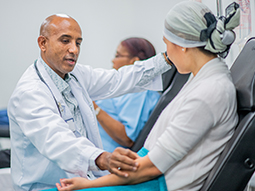Nasal cavity and paranasal sinus cancers include any malignant growth found in the tissues of the nose or sinuses. They are highly treatable if caught early, so it is important to be evaluated immediately if you experience symptoms.
Symptoms
Seek evaluation immediately if you experience any of the following symptoms:
- Nose bleeds
- Runny nose that does not go away
- Persistent congestion
- Swelling behind the eye or in the cheeks
- Facial pain
- Double vision
- Sore throat
- Sinus pressure, with or without headaches
- Earaches
- Problems balancing
- Lumps in the mouth or neck
Types of nasal cavity cancer
Different types of cancer can grow in the nose and paranasal sinuses, including:
- Squamous cell cancer (the most common)
- Melanoma
- Sarcoma
- Inverting papilloma (an aggressive, but benign tumor)
- Midline granulomas
- Minor salivary gland carcinomas
Risk factors
No one knows why a malignant or cancerous growth begins to grow. However, there are certain risk factors for nasal cavity and paranasal sinus cancers. These may include:
- Environmental: exposure to chemicals
- Sex: males have a higher risk than females
- Age: individuals 40 years or older have higher risk
Diagnosis
To make a complete and accurate diagnosis, your doctor will perform the following:
- Medical history
- Physical examination
- Complete exam on your mouth, nose, head, and face to determine the type and nature of the growth
- Biopsy to examine the tumor tissue and determine the kind of cancer, how aggressive it is, and the best way to treat it
- Diagnostic, including imaging studies, lab tests, and detailed physical examinations, including:
- Nasal Endoscopy: to view inside the nose. This is normally done by inserting a scope with a light and camera down the nose
- X-rays
- MRI
- CT scan
- PET scan
Treatments
Treatment for nasal cavity and paranasal sinus cancers depends on when and where the cancer is found, as well as the type and grade of the tumor, and can include:
- Surgery
- Chemotherapy
- Radiation
After your surgery and completing chemotherapy and/or radiation, your doctor will want to monitor you closely to make sure the cancer has not reoccurred. The visits may be as frequent as once a month for the first year following treatment. These visits will typically consist of a physical examination, flexible endoscopy, a discussion of how you are feeling, and any diagnostic tests needed to determine your health.
Our providers

Expert oncology care
Getting the care you need starts with seeing one of our oncologists.









